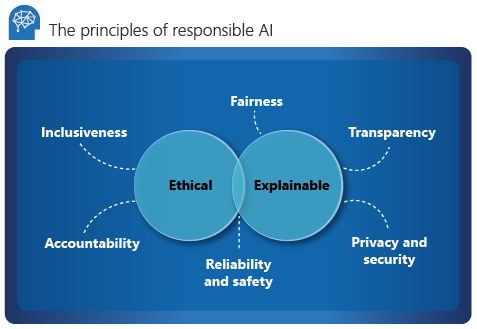Last updated on December 3, 2023
Azure Responsible AI Cheat Sheet
Microsoft outlines six key principles for responsible AI: accountability, inclusiveness, reliability and safety, fairness, transparency, and privacy and security.
Accountability
- People designing and deploying AI systems need to be accountable for their actions and decisions.
- Internal review bodies can provide oversight and guidance in AI systems.
- Considers the systems’ impact and integrating ethical considerations into their development
Inclusiveness
- AI should consider all human races and experiences. Inclusive design practices can address potential barriers.
- Assistive technologies should be used to empower people with impairments.
- Development of systems that respect and include all users
Reliability and safety
- AI systems need to be reliable, safe, and resistant to manipulation.
- Rigorous testing, validation, monitoring, and model tracking processes are important.
- Utilizing a heatmap is a tool for ensuring reliability and safety in AI systems
Explainability
- AI systems should be able to justify their decisions and comply with policies, standards, and regulations.
- Tools like InterpretML help achieve model explainability.
Fairness
- AI systems should not discriminate based on gender, race, sexual orientation, or religion.
- Microsoft provides an AI fairness checklist and tools like Fairlearn for fairness assessment and improvement.
- Ensuring that AI systems treat all individuals equally and do not result in unjust or prejudicial treatment.
Transparency
- Transparency helps understand the data, algorithms, and transformation logic used in AI models.
- Azure Machine Learning provides snapshots for transparency and reproducibility.
- Aims to make AI systems more understandable and explainable to users.
Privacy and security
- Personal data in AI systems should be protected and accessed without compromising privacy.
- Azure differential privacy helps preserve privacy by randomizing data and adding noise.
- Safeguards AI systems against cybersecurity threats.
- Concerned with the protection of user data, ensuring the confidentiality, integrity, and availability of that data
-
- Require transparency about the collection, use, and storage of data.
-
Mandate that consumers have appropriate controls to choose how their data is used
-
References:
-
Learn Azure, Coud Adoption Framework: Responsible and trusted AI
Responsible and trusted AI – Cloud Adoption Framework -
Learn Azure, Azure Machine Learning: Responsible AI
What is Responsible AI – Azure Machine Learning -
Learn Azure, Azure Machine Learning: Workspace
What is a workspace? – Azure Machine Learning -
Microsoft Learn : Trusted AI
https://learn.microsoft.com/en-us/azure/cloud-adoption-framework/innovate/best-practices/trusted-ai -
Microsoft Learn : Privacy and Security
https://learn.microsoft.com/en-us/azure/machine-learning/concept-responsible-ai?view=azureml-api-2#privacy-and-security -
Microsoft Learn : Concept Fairness https://learn.microsoft.com/en-us/azure/machine-learning/concept-fairness-ml?view=azureml-api-2
-
Privacy Preserving Machine Learning Innovation
https://www.microsoft.com/en-us/research/group/privacy-preserving-machine-learning-innovation/ -
Concept Responsible AI https://learn.microsoft.com/en-us/azure/machine-learning/concept-responsible-ai?view=azureml-api-2#privacy-and-security




















